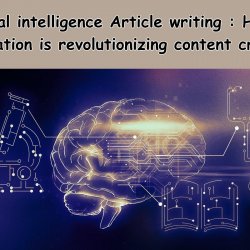What is artificial intelligence and how does it work?


What is artificial intelligence and how does it work?
Introduction
Artificial intelligence , or AI , is a term that we often hear in today’s world of advancing technology . But what exactly is it? How does it work? In this blog section, we will delve deeper into the concept of artificial intelligence and provide you with a better understanding of this rapidly growing field.
To put it simply, artificial intelligence refers to the ability of a machine or computer system to imitate human intelligence . This can be in the form of learning, problem solving, decision making, and even creativity. AI uses algorithms and data to analyze and process information, enabling machines to perform tasks that typically require human cognitive abilities.
One key difference between artificial intelligence and human intelligence is that AI is programmed by humans whereas human intelligence is innate. We are born with the ability to think critically, reason logically and acquire knowledge through experience. On the other hand, AI relies on data and instructions provided by humans to perform specific tasks.
The concept of artificial intelligence dates back to ancient times when Greek mathematicians designed mechanical robots for entertainment purposes. However, it was not until the 1950s that modern AI as we know it today began to take shape. The term “artificial intelligence” was coined by American computer scientist John McCarthy in 1956, who defined it as “the science and engineering of making intelligent machines.” Since then, there have been significant advances in the field of AI, leading us to where we are today.
Definition of Artificial Intelligence
Artificial intelligence, or AI, is a concept that has been gaining more and more attention in recent years. From self-driving cars to virtual assistants, AI technology is quickly becoming a part of our daily lives. But what exactly is artificial intelligence and how does it work? In this blog section, we will dive deeper into the definition of artificial intelligence and explore its key concepts.
At its core, artificial intelligence refers to the development of computer systems that can perform tasks that require human intelligence. This includes tasks such as learning, problem solving , decision making , and even understanding and responding to human speech. AI systems are designed to mimic human cognitive abilities and have the potential to perform these tasks more efficiently and accurately than humans.
To achieve this level of intelligence, AI relies on algorithms and data . Algorithms are sets of instructions that allow computers to solve specific problems or complete tasks. They are the building blocks of AI systems and determine how the system processes information. On the other hand, data is crucial for AI as it provides the necessary information for algorithms to learn from and make decisions.
One of the most important aspects of AI is machine learning . This type of AI involves using large amounts of data to train algorithms so they can improve their performance over time without being explicitly programmed to do so. This enables machines to learn from experience and adapt their behavior accordingly.
Types of Artificial Intelligence
Artificial Intelligence (AI) can be broadly categorized into different types based on their capabilities and functionalities . These categories include:
- Reactive Machines: These are the simplest forms of AI that can only react to specific situations based on predefined rules. Examples of reactive machines include Deep Blue, the chess-playing computer developed by IBM, and various other game-playing AI systems.
- Limited Memory: This type of AI can make decisions based on both current and past data. While they can learn from historical data, they do not have the ability to form long-term memories. Self-driving cars often use limited memory AI to make decisions based on real-time data from their surroundings.
- Theory of Mind: AI with a theory of mind can understand human emotions, beliefs, and thought processes. These systems can interpret and respond to human behavior in a more natural and empathetic manner. While this type of AI is still in the early stages of development, it holds the potential for more advanced human-computer interactions and social AI applications.
- Self-aware AI: This is the most advanced form of AI that has the ability to understand its own existence and consciousness. While self-aware AI is still largely theoretical and not yet realized, it is a concept often explored in science fiction. Researchers and ethicists continue to debate the potential implications and challenges associated with the development of self-aware AI.
Additionally, AI can be classified based on its functionality and application areas :
- Narrow AI (Weak AI): This type of AI is designed to perform a specific task or a narrow range of tasks. It excels in a particular domain but lacks general cognitive abilities.
- General AI (Strong AI): General AI refers to systems that possess the ability to understand, learn, and apply knowledge across a wide range of tasks similar to human intelligence. This type of AI can theoretically perform any intellectual task that a human can. General AI remains a theoretical concept and has not yet been fully realized.
- Artificial Superintelligence: This refers to AI that surpasses human intelligence and capabilities across all domains. It represents a theoretical level of AI that is significantly more advanced than human intelligence and has the potential to outperform humans in every aspect. The development of artificial superintelligence is a topic of significant debate and ethical consideration within the field of AI research.
How Does Artificial Intelligence Work?
Artificial intelligence, commonly referred to as AI, has been a buzzword in the tech world for quite some time now. With advances in technology, AI has become an essential part of our daily lives without us even realizing it. From virtual assistants like Siri and Alexa to self-driving cars and personalized movie recommendations on streaming platforms, AI is everywhere. But have you ever wondered what exactly artificial intelligence is and how does it work? The most critical element of AI is data . Without data, machines cannot learn or make decisions on their own. Data can be classified into two types: structured and unstructured data. Structured data refers to information that is organized in a predefined format that can be easily processed by machines
- Data Collection: AI systems rely on large datasets to learn and improve performance. These datasets may consist of various types of information, including text, images, videos, and structured data. The quality and quantity of the data play a crucial role in training AI models effectively.
- Data Processing and Analysis: AI algorithms process and analyze the collected data to identify patterns, trends, and correlations. This step involves the use of various mathematical and statistical techniques to derive meaningful insights and make informed predictions or decisions.
- Machine Learning: AI systems use machine learning algorithms to enable computers to learn from the data and improve their performance over time. Through the process of training, AI models adjust their parameters to recognize patterns and make predictions based on new inputs. This iterative learning process allows AI systems to become more accurate and effective in performing specific tasks.
- Natural Language Processing (NLP): AI systems equipped with NLP capabilities can understand and interpret human language. NLP enables machines to process and analyze text or speech data, allowing them to generate human-like responses, translate languages, and extract meaningful information from textual content.
- Computer Vision: AI systems with computer vision capabilities can interpret and analyze visual information from images or videos. Computer vision allows machines to recognize objects, identify patterns, and make decisions based on visual inputs, enabling applications such as facial recognition, object detection, and autonomous vehicles.
- Neural Networks: AI models often utilize neural networks, which are computational models inspired by the structure and functioning of the human brain. Neural networks consist of interconnected nodes (neurons) organized in layers, and they are trained to process complex data and make decisions based on hierarchical patterns and features extracted from the input data.
- Decision-Making and Automation: AI systems can make decisions and perform tasks autonomously based on predefined rules and learned patterns. They can automate various processes, optimize workflows, and provide recommendations or solutions in real-time, leading to increased efficiency and productivity in various domains.
You can also read:
star agile data science reviews






Ingen kommentarer endnu